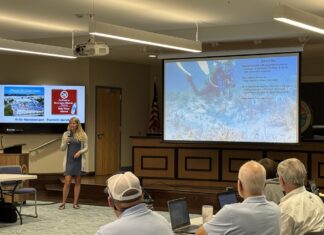For generations, Keys watermen have been terrorizing youngsters with stories of “Big Mo.” Legend has it the 18-foot Great Hammerhead had eyeballs “as big as baseballs” and weighed close to 1,000 pounds. Most tales put Big Mo at the old Bahia Honda Bridge, while others have claimed to spot it, even land it, at 7 Mile Bridge.
Very little is known about the Great Hammerhead, giving strength to the epic “it-was-this-big” lore. And most of what the scientific community does know, it learned in the lab, not in the wild.
The Florida Keys Aquarium and Dynasty Marine have started a nonprofit “R3ACH” program, for just that reason — to study the Great Hammerhead. The Rockerama concert (sidebar) will help fund the research.
“We started the nonprofit in 2013,” said Ben Daughtry. “This Hammerhead project is something Forrest Young and I thought up years ago. We want to better understand the lifecycle of the Great Hammerhead.”
Money raised will fund vessels, experienced scientists and satellite tagging equipment to learn more about the long distance travels of these sharks.
“We hope to piggy back on the aquarium’s research by tagging them with sensors that would be like a ‘daily diary’ or record fine scale information like minute-by-minute water temperatures, depth and swimming speed,” said Florida Atlantic University researcher Steve Kajiura.
The questions start with the most basic — where do they “spawn,” or pup? There are theories, but no scientific evidence. But researchers do know that the Great Hammerhead give birth to live pups, about 25 to 50 at a time.
And why is the shark’s head shaped like THAT? Again, it’s unknown. Some theorize the larger head with more area means more sensors to detect prey. Others theorize the head shape and size offers better mobility. The second is true, but not in the way researchers believed. Rather than giving the Hammerhead shark “lift,” like an airplane wing, it actually works more like a race car’s “foil” offering stability. The difference was reported in a 2004 article in Dive Training magazine, that cited Kajiura’s expertise.
“Recently, I’ve been studying whether the huge nose of the Great Hammerhead gives it some type of advantage,” said Kaijiura. Turns out, it is better at directional smelling that helps it lock on to the prey (which makes total sense if you think about the fact that one nostril could be four feet away from the other; it knows whether to turn right or left).
It wasn’t until the late ’80s, that researchers were able to observe one useful feature of the shark’s shape. It uses the “hammer” to pin down one of its favorite meals — the stingray. “The shark used its head to ‘pin’ the fleeing stingray against the bottom and then pivoted its body into position to deliver an immobilizing bite to the ray’s pectoral disc,” according to a 2002 paper by Demian D. Chapman and Samuel H. Gruber. The Great Hammerhead also eats crabs, squid, shrimp and fish.
Florida Keys Aquarium Encounters and Dynasty Marine are hosting a concert on Saturday, Dec. 1 to fund more research on the Great Hammerhead. Join staffers and friends for a great night of music so we can all know a little more about the
Currently, the Great Hammerhead is on the red list of the International Union for Conservation of Nature (IUCN). In the U.S., only the Scalloped Hammerhead is on the list of endangered species. While populations are reportedly declining, again, little is known about the actual numbers of the Great Hammerhead Shark. Of the nine species, three frequent the Keys — the Great Hammerhead, the Scalloped Hammerhead and the Bonnethead shark.
“Great Hammerheads are actually delicate. They can’t handle the stress of being caught unless your scientists are very, very good,” Kajiura said. “The big advantage of working with the aquarium and Dynasty is that they are very good at live capturing these animals. We have a very good chance of success.”
Rockerama Concert
Saturday, Dec. 1
Doors open at 7 p.m., concert at 8 p.m.
@ Florida Keys Aquarium Encounters, Marathon
Donations $25
To buy tickets, call 305-407-3262
visit floridakeysaquariumencounters.com.





















